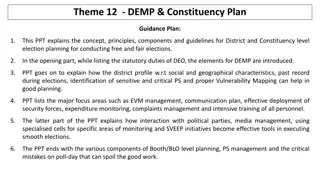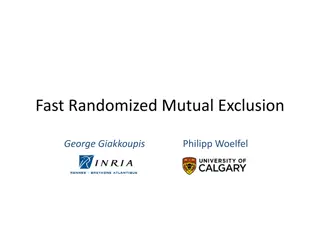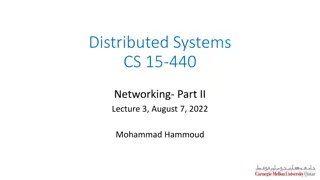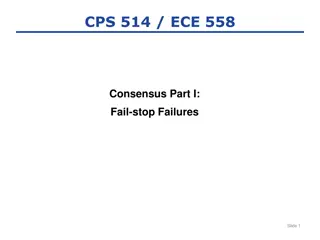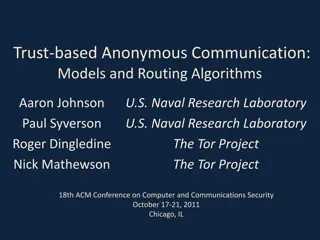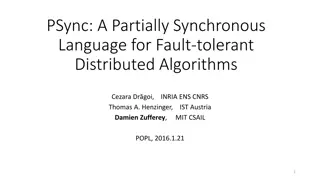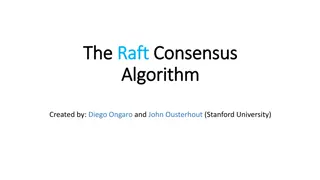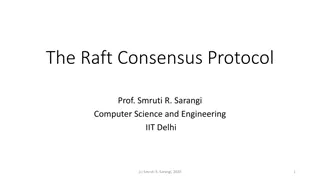Distributed Algorithms for Leader Election in Anonymous Systems
Distributed algorithms play a crucial role in leader election within anonymous systems where nodes lack unique identifiers. The content discusses the challenges and impossibility results of deterministic leader election in such systems. It explains synchronous and asynchronous distributed algorithms, their time and message complexity, and presents asynchronous ring algorithms for leader election. The algorithms described provide insights into the complexities and strategies involved in determining a leader in distributed systems without unique identifiers.
Download Presentation

Please find below an Image/Link to download the presentation.
The content on the website is provided AS IS for your information and personal use only. It may not be sold, licensed, or shared on other websites without obtaining consent from the author.If you encounter any issues during the download, it is possible that the publisher has removed the file from their server.
You are allowed to download the files provided on this website for personal or commercial use, subject to the condition that they are used lawfully. All files are the property of their respective owners.
The content on the website is provided AS IS for your information and personal use only. It may not be sold, licensed, or shared on other websites without obtaining consent from the author.
E N D
Presentation Transcript
Anonymous Leader Election Anastasia Lemetti
2 Anonymous Leader Election Problem 2.1 (Leader Election). Each node eventually decides whether it is a leader or not, subject to the constraint that there is exactly one leader. Definition 2.2 (Anonymous). A system is anonymous if nodes do not have unique identifiers. Definition 2.3 (Uniform). An algorithm is called uniform if the number of nodes n is not known to the algorithm. If n is known, the algorithm is called non-uniform. Lemma 2.4. After round k of any deterministic algorithm on an anonymous ring, each node is in the same state sk. Theorem 2.5 (Anonymous Leader Election). Deterministic leader election in an anonymous ring is impossible.
3 Synchronous and Asynchronous Distributed Algorithms Definition 1.6 (Synchronous Distributed Algorithm). In a synchronous algorithm, nodes operate in synchronous rounds. In each round, each processor executes the following steps: 1. Do some local computation (of reasonable complexity). 2. Send messages to neighbors in graph (of reasonable size). 3. Receive messages (that were sent by neighbors in step 2 of the same round). Definition 1.10 (Asynchronous Distributed Algorithm). In the asynchronous model, algorithms are event driven ( upon receiving message . . . , do . . . ). Processors cannot access a global clock. A message sent from one processor to another will arrive in finite but unbounded time.
4 Time and Message Complexity Definition 1.7 (Time Complexity). For synchronous algorithms the time complexity is the number of rounds until the algorithm terminates. Definition 1.11 (Time Complexity). For asynchronous the time complexity is the number of time units from the start of the execution to its completion in the worst case (every legal input, every execution scenario), assuming that each message has a delay of at most one time unit. Definition 1.12 (Message Complexity). The message complexity of a synchronous or asynchronous algorithm is determined by the number of messages exchanged (again every legal input, every execution scenario).
5 Asynchronous Ring Algorithm 8. Clockwise 1. Each node v executes the following code: 2. v sends a message with its identifier (for simplicity also v) to its clockwise neighbor. {If node v already received a message w with w > v, then node v can skip this step; if node v receives its first message w with w < v, then node v will immediately send v.} 3. if v receives a message w with w > v then 4. v forwards w to its clockwise neighbor 5. v decides not to be the leader, if it has not done so already. 6. else if v receives its own identifier v then 7. v decides to be the leader 8. end if Theorem 2.6 (Analysis of Algorithm 8). Algorithm 8 is correct. The time complexity is O(n). The message complexity is O(n2).
6 Asynchronous Ring (cont.) Algorithm 9. Radius Growth 1. Each node v does the following: 2. Initially all nodes are active. {all nodes may still become leaders} 3. Whenever a node v sees a message w with w > v, then v decides to not be a leader and becomes passive. 4. Active nodes search in an exponentially growing neighborhood (clockwise and counterclockwise) for nodes with higher identifiers, by sending out probe messages. A probe message includes the ID of the original sender, a bit whether the sender can still become a leader, and a time-to-live number (TTL). The first probe message sent by node v includes a TTL of 1. 5. Nodes (active or passive) receiving a probe message decrement the TTL and forward the message to the next neighbor; if the TTL is zero, probe messages are returned to sender using a reply message. The reply message contains the ID of the receiver (the original sender of the probe message) and the leader-bit. Reply messages are forwarded by all nodes until they reach the receiver. 6. Upon receiving the reply message: If there was no active node with higher ID in the search area (indicated by the bit in the reply message), the TTL is doubled and two new probe messages are sent (again to the two neighbors). If there was a better candidate in the search area, then the node becomes passive. 7. If a node v receives its own probe message (not a reply) v decides to be the leader.
7 Asynchronous Ring (cont.) Theorem 2.7 (Analysis of Algorithm 9). Algorithm 9 is correct. The time complexity is O(n). The message complexity is O(n log n).
8 Lower Bounds Definition 2.8 (Execution). An execution of a distributed algorithm is a list of events, sorted by time. An event is a record (time, node, type, message), where type is send or receive . For our lower bound, we assume the following model: We are given an asynchronous ring, where nodes may wake up at arbitrary times (but at the latest when receiving the first message). We only accept uniform algorithms where the node with the maximum identifier can be the leader. Additionally, every node that is not the leader must know the identity of the leader. During the proof we will play god and specify which message in transmission arrives next in the execution. We respect the FIFO conditions for links.
9 Lower Bounds (cont.) Definition 2.9 (Open Schedule). A schedule is an execution chosen by the scheduler. A schedule for a ring is open if there is an open edge in the ring. An open (undirected) edge is an edge where no message traversing the edge has been received so far. Lemma 2.10. Given a ring R with two nodes, we can construct an open schedule in which at least one message is received. The nodes cannot distinguish this schedule from one on a larger ring with all other nodes being where the open edge is. Lemma 2.11. By gluing two rings with open schedules of size n/2 together, we can construct an open schedule on a ring of size n. If M(n/2) denotes the number of messages already received in each of these schedules, at least 2M(n/2)+n/4 messages have to be exchanged in order to solve leader election.
10 Lower Bounds (cont.) Lemma 2.12. Any uniform leader election algorithm for asynchronous rings has at least message complexity M(n) ? 4(log n + 1). Theorem 2.13 (Asynchronous Leader Election Lower Bound). Any uniform leader election algorithm for asynchronous rings has (n log n) message complexity.
11 Synchronous Ring Additional assumptions: We assume that the algorithm is non-uniform (i.e., the ring size n is known). We assume that every node starts at the same time. The node with the minimum identifier becomes the leader; identifiers are integers. Algorithm 10. Synchronous Leader Election 1. Each node v concurrently executes the following code: 2. The algorithm operates in synchronous phases. Each phase consists of n time steps. Node v counts phases, starting with 0. 3. if phase = v and v did not yet receive a message then 4. v decides to be the leader 5. v sends the message v is leader around the ring 6. end if




